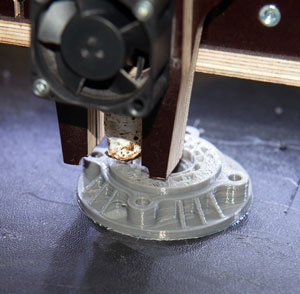KANBrief 3/16

In sectors such as machine construction, medicine and the leisure industry, growing numbers of products are being manufactured by means of additive processes such as 3D printing. These processes are undergoing rapid continual development and are becoming more and more diverse. It is however not easy for the rules for dealing with the hazards associated with these processes to be developed at the same pace as the processes themselves. The legal situation also raises issues.
In additive manufacturing processes, which include 3D printing, the products no longer acquire their form by the removal of excess material from a blank. Instead, the raw materials (liquid plastics; photopolymers; plastic, quartz sand, glass or metal powders; or even paper) are applied in layers or coatings in a controlled thermal, chemical or photochemical process. The new technology is accompanied by risks, however (such as electrical, mechanical, thermal, physical and chemical risks), that have not yet been fully researched.
Strategies for solutions
At the Institute for Occupational Safety and Health of the DGUV (IFA), potential health hazards to workers presented by emissions during additive manufacturing processes are being studied in the project entitled "Hazardous substance emissions from 3D printers"(Contact: Dr Renate Beisser, renate.beisser@dguv.de / Ludger Hohenberger, l.hohenberger@unfallkasse-nrw.de). The project term ends in 2018. In a measurement campaign entitled "Exposure in additive manufacturing processes (including 3D printers)", particular attention is being paid to the materials used and to inhalative exposure to certain hazardous substances. The results of the measurements are to be incorporated into a recommendation by the German Social Accident Insurance Institutions for hazard identification.
Labour inspectors, staff at the test body and hazardous substance experts at the German Social Accident Insurance Institution for the energy, textile, electrical and media products sectors (BG ETEM) meet regularly in the 3D Printing/Additive Manufacturing working group, which serves as a contact point and coordinating body (Contact: Valentin Kazda, kazda.valentin@bgetem.de). The working group is to determine where a need for action exists for occupational safety and health, and is to make information available for the consulting and supervisory tasks of the labour inspectors. For this purpose, the working group cooperates with manufacturers, users, state OSH bodies, and research institutes of the German Social Accident Insurance, such as the IFA.
The "3D printers" project (Project F 2389, "3D printers – Will users become manufacturers? Situation and future of the additive manufacturing and its effects on product safety and the working conditions"), which is being conducted by the BAuA (Federal Institute for Occupational Safety and Health) and is set to run until the end of May 2017, has the aim of considering product safety aspects and legal issues. What duties does the manufacturer of a 3D printer, for example, have to furnish information on the risks that arise? Does the user of the process assume full responsibility as the manufacturer of the resulting product, or does part of the responsibility rest with the manufacturer of the machine? How is responsibility shared for the safety of the process and the final product when software and hardware are supplied by different manufacturers? The planned outcome of this project is an informative document for users of 3D printers.
In a further project conducted by the BAuA (Project F 2410 concerning exposure measurement during tasks involving hazardous substances in additive manufacturing processes – use of powder-bed processes) and running until the end of 2018, the inhalative exposure arising during powder-bed processes and potential hazards presented by the use for example of powders containing metals are to be investigated. The results are to serve as a basis for standardized working methods and EMKG safety guidelines (The BAuA's safety guidelines in accordance with the EMKG concept implement the requirements of the German Ordinance on hazardous substances (GefahrstoffVO) and the body of technical regulations) for additive manufacturing processes.
In the newly formed specialist committee 105.6 of the VDI (Association of German Engineers) concerning safety during the operation of additive manufacturing installations, a VDI Technical Rule is currently being drafted containing recommendations for the reduction of hazards to users during the process of laser-beam fusion of metal powders. In KAN's view, the VDI should ideally not set out any new provisions in this Technical Rule, but should instead make existing information more user-friendly and draw attention to regulatory deficits. Where still needed, product requirements can then be formulated in European or international standards, and requirements concerning the safety and health of workers at work added to the body of regulations of the state or accident insurance institutions.
At ISO, some standards have already been developed or are in preparation in ISO/TC 261, "Additive Manufacturing". These are based in some cases upon VDI Technical Rules. As yet, these standards do not address safety issues, but are concerned with the terminology, technical interfaces, or contractual agreements between customers and service providers. Approximately a year ago however, an ad-hoc ISO group, "Safety issues", was formed with the function of submitting proposals for safety-related standards to TC 261.
Corrado Mattiuzzo
mattiuzzo@kan.de